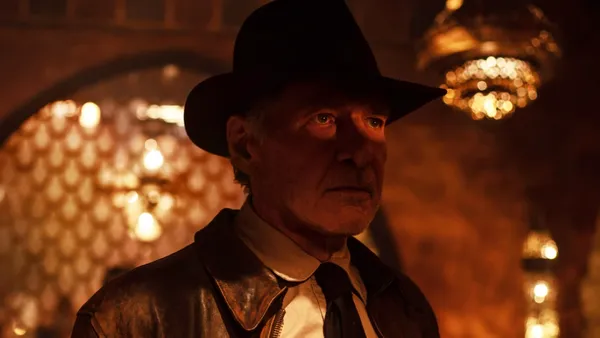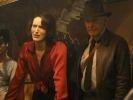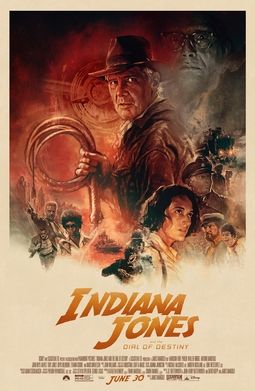Eye For Film >> Movies >> Indiana Jones And The Dial Of Destiny (2023) Film Review
Indiana Jones And The Dial Of Destiny
Reviewed by: Andrew Robertson

We are now as far from the first Indiana Jones film as it was from the Republic (and other) serials that inspired it, but that's not the only tricky arithmetic in this fifth (and final?) film outing for the franchise. While the first three were set in the 1930s, the fourth moved to the 1950s to accommodate the decades between The Last Crusade and those Crystal Skulls. The Dial Of Destiny moves through time again, dressing Glasgow's streets as New York hosting a parade for the Apollo Astronauts. That very specifically dates it to August 13th 1969, a Wednesday.
Collins, Aldrin and Armstrong had a busy day. After that parade they'd attend another in Chicago, before joining the President for a state dinner in Los Angeles. It's one of several small details that are among the delights of Dial Of Destiny that they're not the only ones intending to join Nixon (and then Governor Reagan) at the meal.

Mads Mikkelsen's Doctor Schmidt (or Voller, depending on who's asking) has a flight to catch. Before it though he's looking for what amounts to a guidance computer, an area he has some expertise in as it seems his post-war was part of Operation Paperclip. He's not the only one looking for it though. Indy (Harrison Ford, variously) and god-daughter Helena (Phoebe Waller-Bridge) are also in the hunt.
Voller's henchmen are man-mountain Hauke (Olivier Richters) and mustachioed-marmoset Klaber (Boyd Holbrook), but there's an even more complicated relationship with superfly-spy Mason (Shaunette Renée Wilson). That's not the only difficult partnership. Helena's got a sidekick/child-accomplice in Teddy (Ethann Isidore) whose skills add another dimension to what Short Round used to do. Ke Huy Quan's absence is one of several felt, mostly because so many other faces and features have been brought back.
That includes Harrison Ford's. An opening sequence in or around 1945 features a de-aged or digitally puppeteered Indy, but the voice that comes from it is older. It's more convincing than the work done for Rogue One, though it probably makes use of footage of similar vintage. The similarities between Marion's theme and Han & Leia's theme are a consequence of John William's style, but Harrison Ford's presence in digital reconstruction really foregrounds the parallels. It's much less uncanny than Jeff Bridges in Tron Legacy but the extent to which it's used here feels more of bravery than skill.
Phoebe Waller-Bridge's Helena has both though. Some of which might be attributable to Basil (Baz) played in prologue and flashback by Toby Jones. She manages exposition with charm, and given that she wasn't yet at Primary School for The Last Crusade we could add her to the list of kid sidekicks. That's an unfairness though. A close quarters conversation uses some careful blocks to add additional meaning to an act of decoding. That could have felt stagey, but the tension makes good use of perspective and pace to add more than a few sparks. The byplay between Mikkelson and Waller-Bridge sells most of it, but latterly Ford has been making use of a methodical haggard dismay and it works really well here.
There are a number of jokes about injuries, and age, and while Ford has won a Wright Brothers trophy for services to aviation protests that he's not that old do kind of gloss over the fact that he's an 80-year-old who's been in some plane crashes. There are nods in some places to past films, including an escape sequence that borrows from The Fugitive. That's one of the subtler nods, and it's a mark against Dial Of Destiny that it points many others out.
That said, for every eel that's less lamprey than lamp-shaded there are combinations of material that verge on alchemy. Williams' score continues to contribute and while James Mangold is no Spielberg he's smart enough to steal from the same places. He's dealt with aging within franchises before. Logan and its homages to Westerns past remains a high water mark, but Le Mans '66 (aka Ford Vs Ferrari), the remake of 3:10 To Yuma, and his breakthrough Cop Land all explore similar territory of men out of step and out of time.
Mangold co-writes with several others. Playwright Jez Butterworth has worked with Mangold several times before, as well as working on the similarly self-referential Bond film Spectre. Jez's brother John-Henry joins in. He's contributed to a half dozen (or a third) of his sibling's scripts, among those a potential thematic parallel to those Mangold pictures in Black Mass. David Koepp rounds out the list. He's no stranger to franchises with credits for Crystal Skull, Jurassic Park, the 2002 Spider-Man and the first Mission: Impossible.
On that note, audiences are being given a choice this summer between latter outposts in a franchise starring actors who've been in the same roles for decades that coincidentally feature fights on top of steam trains and chase sequences involving Fiat 500s. That while in pursuit of vaguely bronze partially-magical mechanical devices through a number of countries and cities with some support from vertical-takeoff capable aircraft operated by the United States Marine Corps. They've even got younger female companions who are capable of conjuring tricks and old faces returning to help people with new allies who come with implied backstories. Maybe it's something in the water.
Either way I enjoyed it. I'd used 'haggard' earlier, as H Rider was and remains an influence, but as with the ninth Star Wars film and the seventh Mission: Impossible and the 23rd, 24th, and 25th Bond films and the 32nd MCU picture, these are creations that are no longer devouring other works but themselves. Dune might have the big worms but it's not the only place where tales are eating themselves. There's a difficult place between homage and pastiche, between nostalgia and the new. Indiana Jones rightly fights Nazis but his films hearken to an imagined and romanticised past, doubly so here where the conservative impulse extends to trying to reach back in time to try again with the same tools. That's not a criticism born of the implicit, these are themes that Dial Of Destiny wrestles with, near-literally.
That's what saves it, more or less, from the unmaking that Jormungandr letting go his tail would bring. I know I contribute to the mess by lamenting that the old Indy here doesn't look like the oldest Indy from the Young Indiana Jones Chronicles, a role for George Hall that revelations from The Fabelmans suggest owes a debt to John Ford (as played by David Lynch). The eye for film in this website's name was not dropped in the well of knowledge just for a patch. We're at the point that it's not mere fakery but layered reproductions, artefacts of mimicry like pixel-cruft or fax-lore. There might even be a nod to that, there's a loop ostensibly unclosed that requires audiences pick up that someone else might have picked something up. Unlike some of the film's tricks that's not an outcome that's forced, but one whose magic comes from everything around it. At that, but not at least, Dial Of Destiny succeeds. That old magic, back again, and proven well enough to be close to fact.
Reviewed on: 06 Jul 2023


















